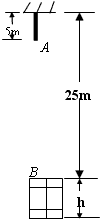有一根长L=5m的铁链悬挂在某楼顶上,楼中有一窗口,窗口上沿离铁链的悬点H=25m。当铁链从静止开始下落后始终保持竖直,不计空气阻力,g=10m/s2。求:
(1)铁链的下端A下落到窗口的上沿B时,铁链的速度大小;
(2)接着铁链经过整个窗口时用了t=0.3s的时间,窗口的高度h为多少?

(1)v=20m/s
(2)h=1.45m
有一根长L=5m的铁链悬挂在某楼顶上,楼中有一窗口,窗口上沿离铁链的悬点H=25m。当铁链从静止开始下落后始终保持竖直,不计空气阻力,g=10m/s2。求:
(1)铁链的下端A下落到窗口的上沿B时,铁链的速度大小;
(2)接着铁链经过整个窗口时用了t=0.3s的时间,窗口的高度h为多少?

(1)v=20m/s
(2)h=1.45m